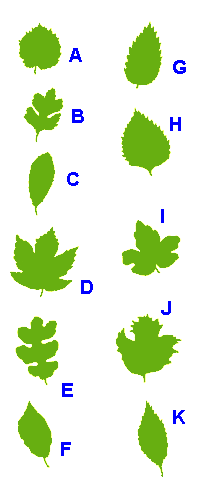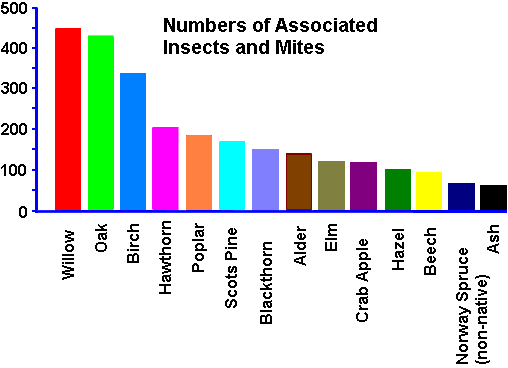
|
A
|
Hazel
|
The common variety shrub has a smooth and shiny bark that peels. It can grow to 40 feet. The nut is brown with a woody shell. It is important for poles that are coppiced at intervals. It is use for headgerows and undershrubs in woods. Other kinds are Turkish (and SE Europe), Filbert (often ornamental) but different are the Witch Hazels.
|
|
B
|
Hawthorn
|
The Common or Quickthorn is cultivated into hedges but will grow into a tree up to 50 feet high. glucose to ovate, bright red to maroon fruit in May to september gives food for wintering birds. The white to pink flowers emerge March to June. Others include the Midland (C Europe) and Cockspur (varieties).
|
|
C
|
Blackthorn
|
It is also called Sloe, the name of the fruit which is bluish black with a blue-grey surface bloom. It is seen in hedges and thickets with spiny and downy branches, growing wild in Britain and nesting birds like this density cover.
|
|
D
|
Sycamore
|
Part of the Maple family this introduced tree can grow to 100 feet tall. The grey bark is fissured and can peel leaving orange patches. The yellowish flowers come in april. It offers shelter and ornament. The wood is very hard and is seen in veneers as well as other forms of woodwork.
|
|
E
|
Oak
|
A tree with fissured pale grey bark. It flowers in May to June and the acorns ripen from the first year in October. It likes basic soils. Very good for timber it can grow to well over 100 feet and with up to 40 feet girth. It is very supportative of wildlife. There are many kinds of oaks including Red (E North American, to C Europe), Scarlet (E North American, to E & C Europe), Pin (E North American, to C Europe), Holm (Mediterranean), Cork (W Mediterranean, planted for its bark or cork of commerce), Turkey (CS & SE Europe), Kotschy (Aegean and Balkans), Macedonian, Sessile/ Durmast (general Europe), Koch (SE Europe), Hungarian (and around), Downy (most Europe and W Asia), Pyrean, Ten (S Europe) and Mirbeck's/ Algerian (Spain, N Africa).
|
|
F
|
Beech
|
This is grown for timber, shelter and ornament, growing well over 120 feet. Its bark is smooth or slightly rough and grey. It flowers in May and is best seen on chalk. The dense foliage lets only a small amount of sunlight to the woodland floor. Others include the oriental (SE Europe) and Roble (Chile and W Argentina).
|
|
G
|
Rowan
|
Confusingly includes the Mountain Ash with creamy white flowers and bright red fruit when ripe. It is very tolerant of soil conditions and has been a street tree or garden ornamental. It was once planted to keep witchcraft at bay. The hard wood has been turned into tool handles.
|
|
H
|
Common Lime
|
A dull grey bark that is smooth when young but fissured later. It produces yellowish white flowers in July. This is a hybrid of the large leaved (NW Europe seen in streets) and small leaved (middle Europe, a street tree) Limes, two other types. Others include Silver (SW Asia and Balkans, Ukraine and Hungary and is ornamental), Weeping Silver (Caucasus, seen in churhyards and parks), Caucasian, and is the most frequently planted lime in avenues and on roadsides. It can reach 150 feet tall.
|
|
I
|
Field Maple
|
Often seen as a small shrub in hedgerows it can however reach over 70 feet high in good conditions. The bark is grey or brown with orange fissures. In autumn it has bright yellow leaves. Other Maples around the world include Heldreich's (Chinese), Paper bark (Chinese and popular here, reddish brown bark that peels), Père David's, Balkan (Balkan and Caucusus), Boiss (south Spain and north African), Montpelier, Cretan, Box-elder (originally eastern North American), Italian (western Mediterranean and southern Alps), Waldst & Kit (close to the Italian but more eastern), Smooth Japanese (usually in gardens and parks and as a shrub), Downy Japanese (usually in gardens), Norway (European forest tree and ornamental), Silver (American, a street tree here), Red (American, ornamental here including churchyards) and Tartar (European).
|
|
J
|
Guelder Rose
|
The is the viburnum opulus and it is not a rose. It grows to 15 feet with a show of white, wheel shaped clusters of flowers the outer ones of which are sterile and the inner ones fertile. The fruit is red and persists after the leaves have dropped.
|
|
K
|
Ash
|
The fraxinus tree may reach 140 feet in good conditions in the Common variety. It flowers around May and the fruit exists as winged nuts or "keys" which can stay on the tree into winter. The bark is grey to brown depending on the exact variety (Manna, Red, White, Common, Narrow leaved, Wilmott). One of our most valuable timber trees and the timber hard and elastic and offers toughness.
|
